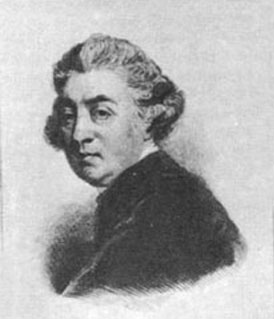| Sir William Chambers  Born: 1723 Born: 1723
Birthplace: Göteborg, Sweden
Died: 8-Mar-1796
Location of death: London, England
Cause of death: unspecified
Gender: Male
Race or Ethnicity: White
Occupation: Architect Nationality: Scotland
Executive summary: Treatise of Civil Architecture British architect, the grandson of a rich merchant who had financed the armies of Charles XII, but was paid in base money, and whose son remained in Sweden many years endeavoring to obtain redress. In 1728 the latter returned to England and settled at Ripon, where William, who was born in Stockholm, was educated. At the age of sixteen he became supercargo to the Swedish East India Company, and voyaging to Canton made drawings of Chinese architecture, furniture and costume which served as basis for his Designs for Chinese Buildings, etc. (1757). Two years later he quitted the sea to study architecture seriously, and spent a long time in Italy, devoting special attention to the buildings of classical and Renaissance architects. He also studied under Clérisseau in Paris, with whom and with the sculptor Wilton he lived at Rome. In 1755 he returned to England with Cipriani and Wilton, and married the beautiful daughter of the latter. His first important commission was a villa for Lord Bessborough at Roehampton, but he made his reputation by the grounds he laid out and the buildings he erected at Kew between 1757 and 1762 for Augusta, princess dowager of Wales. Some of them have since been demolished, but the most important, the pagoda, still survives. The publication in a handsome volume of the designs for these buildings assured his position in the profession. He was employed to teach architectural drawing to the prince of Wales (later George III), and gained further professional distinction in 1759 by the publication of his Treatise of Civil Architecture. He began to exhibit with the Society of Artists in 1761 at Spring Gardens, and was one of the original members and treasurer of the Royal Academy when it was established in 1768. In 1772 he published his Dissertation on Oriental Gardening, which attempted to prove the inferiority of European to Chinese landscape gardening. As a furniture designer and internal decorator he is credited with the creation of that "Chinese Style" which was for a time furiously popular, although Thomas Chippendale had published designs in that manner at a somewhat earlier date. It is not unreasonable to count the honors as divided, since Chippendale unquestionably adapted and altered the Chinese shapes in a manner better to fit them for European use. To the rage for every possible form of chinoiserie, for which he is chiefly responsible, Sir William Chambers owed much of his success in life. He became architect to the king and queen, comptroller of his majesty's works, and afterwards surveyor-general. In 1775 he was appointed architect of Somerset House, his greatest monument, at a salary of £2000 a year. He also designed town mansions for Earl Gower at Whitehall and Lord Melbourne in Piccadilly, built Charlemont House, Dublin, and Duddingston House near Edinburgh. He designed the market house at Worcester, was employed by the earl of Pembroke at Wilton, by the duke of Marlborough at Blenheim, and by the duke of Bedford in Bloomsbury. The state coach of George III, his constant patron, was his work; it is now in the Victoria and Albert Museum. Although his practice was mainly Classic, he made Gothic additions to Milton Abbey in Dorset. Sir William Chambers achieved considerable distinction as a designer of furniture. In addition to his work in the Chinese style and in the contemporary fashions, he was the author of what is probably the most ambitious and monumental piece of furniture ever produced in England. This was a combined bureau, dressing-case, jewel-cabinet and organ, made for Charles IV, king of Spain, in 1793. These combination pieces were in the taste of the time, and the effort displays astonishing ingenuity and resource. The panels were painted by W. Hamilton, R.A., with representations of the four seasons, night and morning, fire and water, Juno and Ceres, together with representations of the Golden Fleece and the Immaculate Conception. The organ, in the domed top, is in a case decorated with ormolu and Wedgwood. This remarkable achievement, which possesses much sober elegance, formed part of the loan collection of English furniture at the Franco-British Exhibition in London in 1908. Sir William Chambers numbered among his friends Samuel Johnson, Oliver Goldsmith, Joshua Reynolds, David Garrick and Dr. Burney.
Author of books:
Designs for Chinese Buildings (1757, architecture)
Treatise of Civil Architecture (1759, architecture)
Dissertation on Oriental Gardening (1772)
Do you know something we don't?
Submit a correction or make a comment about this profile
Copyright ©2019 Soylent Communications
|